Question on structure of council to be on 2026 election ballot
Administrator | Apr 13, 2025 | Comments 2
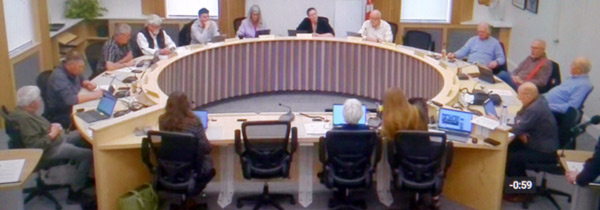 By Sharon Harrison
By Sharon Harrison
Council heard details of the steps required for adding a question to the ballot for next year’s municipal election as it pertains to the governance structure of council (size of council, ward boundaries, etc.).
While council received the report from the corporate and legislative services department for information purposes only, during Thursday’s committee of the whole meeting, considerable discussion ensued resulting in an amendment being put forward by councillor Phil St-Jean.
The amendment, which passed 12-2 in a recorded vote (with councillors Harrison and Pennell opposed), suggested the question to be asked on the ballot is: “Are you in favour of a comprehensive governance review which would look at council size, ward boundaries, structure, and method of election?”
“It is important,” said St.-Jean. “It is time to get down to the brass nuts of it and actually make a decision, chose a path and move forward.”
Councillor Roy Pennell said he would not support the motion “as it’s got too many things in, I think it’s too much. I just want a plain question and let next council, who will be making the decision, make the decision at that time, and they can include anything and everything they want.”
Pennell said it is imperative that every municipality re-evaluate where they are from time-to-time, where he also said there should be an in-depth study by council to try to trigger where there might be problems that could be solved with one question, and it might be an entirely different question on the ballot.
Pennell also noted his biggest concern was wards changing, noting that would be a “big concern” for the residents of Ameliasburgh.
“There is a need to review our governance and perhaps come up with a question that way. When I see little things thrown in, like the possibility of a deputy mayor or whatever, I get really alarmed. If we are looking at lowering of council, I want to be clear around the question. I do support a governance review, I think it’s the right thing.”
Councillors were presented with three question options for consideration, outlined in municipal clerk’s Victoria Leskie’s report (further explanation at end of article), namely:
Question option (1): Are you in favour of a review to look at council size and related ward boundaries? (this relates strictly to size of council and ward boundaries);
Question option (2): Are you in favour of a review to examine council structure and method of election of members of council? (this relates to everything but the size of council and the ward boundaries);
Question option (3): Are you in favour of a comprehensive governance review which would look at council size, ward boundaries, structure, and method of election? (this relates to everything).
While a number of councillors stated they preferred question option (3), there was a lot of discussion, along with some disagreement and confusion, from members especially surrounding the level and type of public communication (as opposed to public consultation) to take place prior to the electoral period.
Councillor St-Jean was concerned about the intended impact, indicating how it may confuse or may even influence the public’s decision “when the whole point of process is to ask the public their opinion without us trying to manipulate that position.”
Councillor Janice Maynard suggested a new question option (4) – a prelude option – be considered with such option using the information to inform council with a question on the ballot which would gauge public opinion beforehand, and could also be used as a learning tool to give people the advanced knowledge that something is coming up, she said.
“I see this as the step to make us better informed, not only us but the public informed of this whole topic, I see one following the other,” explained Maynard. “Because this is such a complex issue, this allows at least some pre-consultation on the myriad of issues that come with the restructuring of council. I am requesting that we consider this option (4) and then decide what option we decide.”
Councillor John Hirsch expressed how he has changed his view on the subject, but agreed it is time to ask the public if they are in favour of a comprehensive review.
“We are hearing every single day in all forms of media, through our emails, through our phone calls, through the papers, everywhere, that people are dissatisfied and the respect for council is dramatically lacking at this point in time,” said Hirsch. “So, it’s about time then that we ask the public what they think.”
He said a simple clean ballot question is a way to start that process.
“With that on the ballot, I would suggest the next election may attract some candidates of quality who are interested in this issue and would have something valuable to add to it.”
Councillor Phil Prinzen said he was in favour of putting a question on the ballot, but was not in favour of a council size lowering.
“The public will let us know what they want and we are here to serve the public. I do have a little bit of hesitations, but could support one of these questions, although in my heart, I don’t know if I am in full support.”
Mayor Steve Ferguson also supported question option (3), indicating how as a corporation it has never gone through this exercise since amalgamation and “it’s about time we did”.
“The community has changed, the community is changing, and we as a municipal government must review the way in which we do things based on those changes,” stated Ferguson. “The comprehensive review may come back with ‘everything’s great, let’s leave it the way it is’, but I think there will be changes proposed as we go through the process.
It’s really, really important for us to do and it is our responsibly to do it on a more regular basis than every quarter century.”
Public comments received came in the form of an in-person deputation by Gary Mooney, and a virtual comment from Penny Morris.
Mooney provided a number of reasons why council might decide to vote against adding a question to the ballot surrounding downsizing or reviewing council. Speaking specifically to council size, he asked that any referendum question exclude any reference to the possibility of downsizing council.
“Much of the character of the County comes from being a collection of communities, each with differing interests and needs much appreciated by residents. Downsizing council would necessitate restructuring the wards which would lead to the loss of much of our unique structure as a community of communities evolved of over more two centuries,” expressed Mooney.
He urged council to reject the suggested plan because no one has made a compelling case for downsizing council. “Such a referendum question would be an attempt to influence the next council, which is inappropriate.”
“As voter turnout is now always less than 50 per cent, the result would not be binding on the next council, so why ask the question? In the highly unlikely event that the turnout is 50 per cent or more, the result would be binding on the next council, but is even more inappropriate.”
Mooney continued stating the use of a simple question with just a yes or no answer would not be very helpful in dealing with a complex issue.
“The most important reason is that council has the freedom to act without a referendum. This council considered the issue and rejected it, the next council would have the same opportunity. It would be a waste of everybody’s time to hold a referendum.”
Picton resident Penny Morris was in favour of including a question regarding governance structure on the 2026 election ballot, and said she supports question option (3).
She noted how the importance of maintaining and improving democracy is increasingly recognized. “It’s been almost 15 years since the changes that were implemented in 2016 were initiated in 2010.”
“It may be suggested to wait and see if our population grows significantly over the next few years, however, any question on the 2026 ballot wouldn’t be implemented until at least 2030, pushing this down the road will add a minimum of four more years.”
Morris said it was up to the people to decide if a question should be added to the ballot.
“We can’t pre-suppose voter turnout or numbers answering the question or the results. I am in favour of a comprehended review question which looks at every aspect of our municipal governance. This is an opportunity to make substantive change if that is the will of the population,” added Morris.
She also reminded that if it doesn’t get enough support and is not legally-binding, council does have the opportunity to make changes and they don’t have to wait for a referendum. “There’s been a significant amount of change and there is room for huge amount of improvement in terms of governance as a whole.“
2010 ELECTION BALLOT QUESTION
The structure and size of council were determined through a negotiation process and a transition team in 1998 during amalgamation of the previous 10 wards, towns and villages into one single-tier municipality.
“It has been a topic for debate, and often contention, since then,” said Leskie. “Previous councils have considered the issue through several exercises, including a question on the ballot in the 2010 municipal election.”
The last time a question was added to the election ballot was in 2010, which asked, “Are you in favour of council commencing a public consultation process to review the size of council for the County of Prince Edward?”
In 2020, of the eligible electors (22,403), 10,614 ballots were cast with 9,381 (41.87 percent) voting on the ballot question. 7,578 (80.78 per cent) answered yes to the question, 1,803 (19.21 per cent) voted no to the question.
Under the municipal elections act, more than 50 per cent of the eligible electors are required to answer the question for it to be legally binding, which did not happen in 2010 as only 41.87 percent voted on the question.
“Although the results were not legally binding, council proceeded with a review through the citizen’s assembly process and a held a series of public meetings,” explained Leskie in her report. “Following that process, council reduced the number of councillors in Sophiasburgh ward from two to one, eliminated the ward councillor and boundaries for Bloomfield ward and merged Bloomfield ward with Hallowell ward.”
This resulted in reducing the size of council from 16 to 14 members, and reduced the number of wards from 10 to nine wards.
Should the ballot question go ahead at the upcoming municipal election, the results of a question would only be legally binding if at least 50 per cent of the eligible electors vote on the question, and if more than 50 per cent of the voters voted yes.
Traditionally, voter turnout has been less than 50 per cent in Prince Edward County, and if that is the case in 2026, the results would not be legally binding, notes Leskie.
“However, the results could still provide council and the public with an indication of public opinion on the matter,” she said. “The results gleaned may also guide council in its decision making on whether to undertake a governance review following the 2026 municipal election. Any changes which may result in the size of council or ward boundary configuration would be in effect for the 2030 municipal election.”
Councillor Chris Braney said he was encouraged at how council was coming together collectively as a team, describing it as a valuable process, as he spoke to the importance of the question and undertaking the process, and said question option (3) was “very clear and concise, and a no brainer”.
“We are understanding the importance, first of all to our residents, and more importantly, our obligation with a corporation this size to undertake a healthy evaluation of governance, including size of council,” explained Braney. “This is a healthy process that we should be looking at every 5-7 years with an organization this size.”
“We have had a fulsome conversation about this, and I do appreciate the strong majority of council in seeing the merit of moving forward with this in answering the calls and concerns from many of our residents,” added Braney.
Should council opt to proceed with adding a question to the ballot, there is a process to be followed, to include public consultation and legal review, all of which must be completed by March 1, 2026 (for the October 2026 election). There would be no significant costs incurred for adding a question on the ballot, according to the municipal clerk.
BALLOT QUESTION OPTIONS EXPLAINED
The three question options presented to council for consideration are repeated below, along with a brief explanation for each provided by municipal clerk, Victoria Leskie.
Question option (1): Are you in favour of a review to look at council size and related ward boundaries?
Leskie explains that this question directly addresses the largest issue and the dilemma for many.
“Some may suggest that council size should be reduced, but do not wish to see any changes to the existing ward boundaries. In that case the answer would be NO. For those with an appetite for change, which would by necessity include changes to ward boundaries, the answer would be YES.”
She outlines that option (1) does not identify other aspects of a full governance review, as outlined in the other question options.
This question would be accompanied by public communications materials which would explain how any adjustment to the size of council would impact representation and would require changes to existing ward boundaries. It would also explain the process and estimated costs of conducting the review process and consequences that could result from the review.
Question option (2): Are you in favour of a review to examine council structure and method of election of members of council?
This offers the opportunity for council to conduct a review of other aspects of governance rather than size of council and ward boundary configuration.
“This question would be accompanied by public communications materials which would explain the various models of council and different methods of election, to include some come Councillors being elected at-large and some by-wards, an elected deputy mayor, and the use of committees of council, advisory committees and boards and ad hoc committees.”
The materials would also explain the process and estimated costs of conducting the review process and consequences that could result from the review.
Question option (3): Are you in favour of a comprehensive governance review which would look at council size, ward boundaries, structure, and method of election?
This question combines questions one and two and would be accompanied by public communications materials which include both explanations listed above.
Filed Under: Featured Articles • Local News
About the Author:














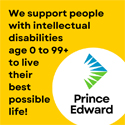

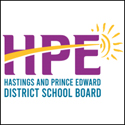


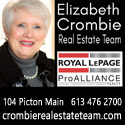


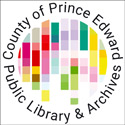










“Traditionally, voter turnout has been less than 50 per cent in Prince Edward County, and if that is the case in 2026, the results would not be legally binding, notes Leskie.”
I find it interesting (and questionable) that it requires less eligible votes to secure a ward councillor in our municipal election, than to put this question on the ballot and expect it to be accepted by a higher number of votes. So, why is this a different requirement?
Why not let the residents decide what question they want on the ballot? Post the three wordings on the County’s “Have Your Say” portal. Council does enough deciding on our behalf, let us have a run at it.